“Finished Zippers” are what most folks think of when they want a zipper. There are a few things that define what a specific zipper actually is. Most of the time the length and color of a zipper come to mind, and although that is important, they are actually the least important when we try to determine the right zipper for an application. The things to keep in mind are what the zipper is going to be used for and for how long it is going to be used in that way. From there we determine the configuration of the zipper (more on that in a minute) and what materials the zipper parts should be made out of; the actual fabric, teeth, slider, and stops are all made from materials we can change (this is explained at the end of this section).
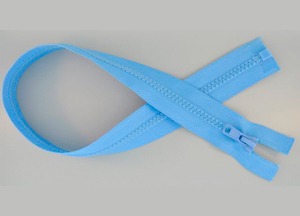
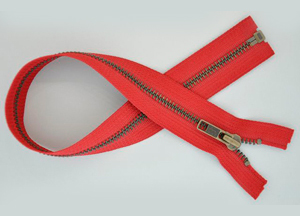
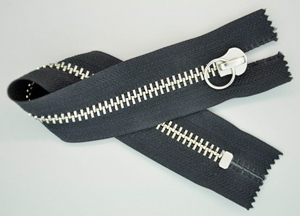
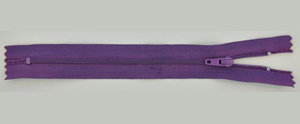
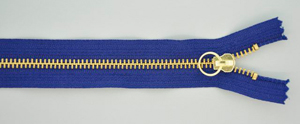
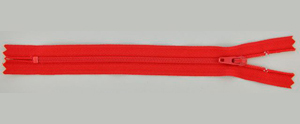
First, let’s talk about the configuration of a zipper. The configuration is the way the finished zipper is assembled to perform a specific task. The two most common types are those that separate as in a jacket, called a SEP (separating) or open ended zipper, and those that do not, as in a pair of pants, called an open top or closed end zipper. The other types of zippers range from two way separators, like those in winter coats that can be opened a little bit from the bottom while you are wearing them so you can sit comfortably in a chair or the car, to bridge top zippers that you might find on a pillow case where both ends of the zipper have a stop fasted to hold the zipper closed at both ends even when the zipper is actually open. Then there are the more uncommon finished zippers, X-type zippers that have two sliders oriented bottom of slider to bottom of slider, luggage type zippers that also have two sliders but facing the other direction or top or slider to top of slider, and on and on. You can see more on all these configurations in the finished zipper section.
 Second are the materials the zippers are made of. These materials refer not only to the fabric of the sides of the zipper, called the tape, but to all the parts of the zipper. We can make metal tooth zipper, nylon coil tooth zipper, and variations of plastic tooth type zippers. The metals alone could be brass, nickel, aluminum, stainless steel, etc. Then there are the finishes on the metals; from antiques to blackened, from polished to anodized, the possibilities are endless. The fabrics for the tape of the zipper chain can be polyester, cotton, or even fire retardant materials. For the certain zippers we can even make waterproof tapes, woven plastic tapes, vinyl tapes, even some specialty zippers can be made with genuine leather tape. The sliders and pullers that operate the zippers are also made of many materials. Although die cast zinc is the most common. This material is durable, inexpensive, easily molded, and can take on appearances of metal through plating or colors through paint application. Finally there is the stops that define the configuration and aide in the functionality of the zipper. They too can be made of a multitude of things; from metals in brass and aluminum to plastics in delrin and nylon to ultrasonically applied adhesives that act as stops. The specifics of the different material options are discussed throughout the specific parts of the item sections.
Second are the materials the zippers are made of. These materials refer not only to the fabric of the sides of the zipper, called the tape, but to all the parts of the zipper. We can make metal tooth zipper, nylon coil tooth zipper, and variations of plastic tooth type zippers. The metals alone could be brass, nickel, aluminum, stainless steel, etc. Then there are the finishes on the metals; from antiques to blackened, from polished to anodized, the possibilities are endless. The fabrics for the tape of the zipper chain can be polyester, cotton, or even fire retardant materials. For the certain zippers we can even make waterproof tapes, woven plastic tapes, vinyl tapes, even some specialty zippers can be made with genuine leather tape. The sliders and pullers that operate the zippers are also made of many materials. Although die cast zinc is the most common. This material is durable, inexpensive, easily molded, and can take on appearances of metal through plating or colors through paint application. Finally there is the stops that define the configuration and aide in the functionality of the zipper. They too can be made of a multitude of things; from metals in brass and aluminum to plastics in delrin and nylon to ultrasonically applied adhesives that act as stops. The specifics of the different material options are discussed throughout the specific parts of the item sections.

